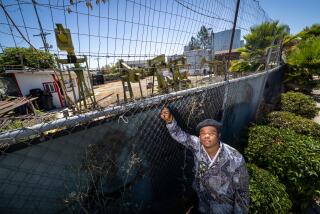City Streets Make Radical Vacation Spot
- Share via
From the back of a flatbed truck packed with loudspeakers, puppets and assorted protest signs, two guys from East Los Angeles have lived this week like their own Magical Mystery Tour.
They’ve seen actors dressed like “billionaires” mocking the wealthy. They’ve seen drummers and dancers and a huge cardboard “nuclear missile” rolling down Figueroa. They’ve seen 500 teenagers march an entire block in perfect silence.
“It’s surreal,” Carmelo Alvarez said as the truck rolled through downtown. “In real life, you never get to do stuff like this.”
Alvarez and a friend who goes by the name of Menoman have been providing a mobile stage and sound system for the protesters, working for donations. As of Wednesday afternoon, they had parked their truck at 10 rallies and marches, driving back and forth across the heart of Los Angeles, from MacArthur Park to Pershing Square to Staples Center, taking it all in.
What they’ve witnessed has been part rage, part comedy, a mishmash of causes joined together by a common spirit, the sense that America is losing its way in a sea of money, power and superficiality.
As protester Charles Poper put it while hitching a ride on the truck along Wilshire: “The world is in jeopardy. Humanity is in jeopardy. We need to slow down and stop looking at profits and the bottom line.”
Poper is a bus driver for the Orange County Transit Authority who took a weeklong vacation to hang out downtown with the protesters, to feel for a few days the joy of collective action, the unique rush you get when you’re standing with a thousand people all yelling the same thing.
“Whose streets?” starts one chant repeated at nearly every protest. “Our streets!”
Untold thousands of people have made this week their radical vacation. They’ve taken days off work or called in sick to join in one march or maybe several, picking from the smorgasbord of events listed on protest Web sites.
“This is a movement, a real beautiful movement,” says Lisa Ferguson, 37, a videographer and writer working at the Independent Media Center. “I’m just moved to the point of tears at least three times a day. The spirit is that of a collective. We’re all sharing.”
Ferguson is the daughter of jazz musician Maynard Ferguson, who was “one of the first people to drop acid with Timothy Leary,” the ‘60s guru who urged his generation to “turn on, tune in and drop out,” she said.
*
A child of the older generation of radicals, Ferguson sees something different in this one: “It’s not just a replay of the ‘60s. They’ve figured out what the mistakes were. In the ‘60s it was very hierarchal, very sexist. There were a lot of egomaniacs.” The media collective she’s working with this week couldn’t be more different. “They do everything by consensus. They try to make sure there are no two white men in any level of power.”
The idea of shared leadership and consensus comes in large part from the anarchist movement, a 19th century ideology that’s found a new life on the cusp of the 21st.
“Anarchism is about not forcing anyone to do anything they don’t want,” said Marcus Page, a 34-year-old puppeteer from Tacoma, Wash. “It’s all about nonviolent protest.”
Of course, there are a few anarchists on the streets of the city this week who don’t see their movement as one that should avoid violent confrontations. They are the ones who seem to be on the fringes of every protest, young men and women dressed in black, huddling in tight groups, deigning to grant interviews with the “corporate media.”
Other activists here have been treating these radical anarchists like the troubled little brothers of the movement--they want the angry youth to feel “included,” a part of the family, but also worry about what craziness they might unleash next.
It was possible to see this dynamic at work Tuesday night at the “Queers and Allies Action March.” As the demonstration reached its finale in front of the Federal Building, a group of black-clad youth drifted away from the main body of protesters toward the edge and the line of police officers blocking the street.
One of the “security” volunteers for the march held out her arms to direct them away.
“OK, guys,” she said in an even voice. “We’re just making a circle. Please, let’s make a circle.”
The “Black Block” wasn’t into making circles. But they didn’t do anything violent either. One of their members simply took out a piece of chalk and wrote a message on the street, words directed, apparently, toward the media: “Focus on the real issues.”
But what are the real issues? Global warming? Police brutality? Fluoridated water? The death penalty? Bicycles as an alternative to fossil fuels? All those causes have been addressed this week by protesters, many of whom have gone to jail for their beliefs.
What is it, exactly, that unites this kaleidoscope of activists?
Think of them as the anti-power crowd. They are the antimatter that orbits around the fat cats wherever they might assemble--be it Seattle, Washington or Philadelphia. And, this week, Los Angeles.
More to Read
Sign up for Essential California
The most important California stories and recommendations in your inbox every morning.
You may occasionally receive promotional content from the Los Angeles Times.











